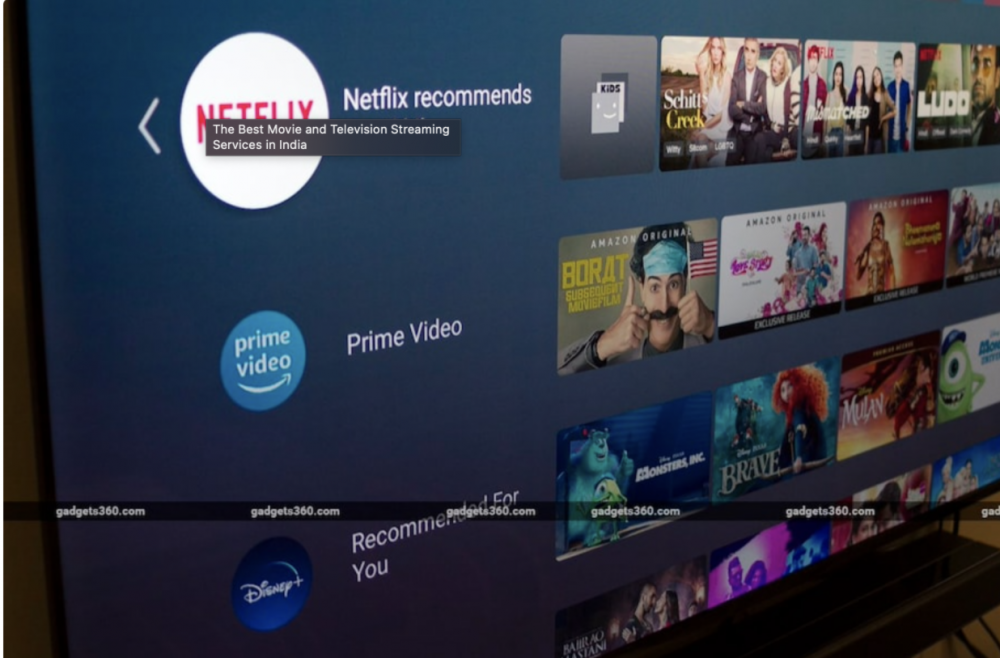
RIA BHANDARKAR – OCTOBER 12TH, 2021
EDITOR: ATMAN MOHANTY
It wouldn’t be hyperbolic to say that the entertainment industry is experiencing one of the biggest disruptions of any sector in the American economy. Since well before the COVID-19 pandemic, more and more films and television series have been distributed on streaming platforms rather than cable, network channels, or theaters. However, after the pandemic began, and as more and more viewers wanted easy access to content without venturing outside of their homes, streaming services have exploded. Online video streaming services reached over a billion subscriptions in 2020. That’s 50% more than before the pandemic.
While it seems to be smooth sailing for streaming platforms, there are plenty of caveats to consider when quantifying the dominance of Netflix, HBO Max, Hulu and other streaming platforms. Some streaming services, such as Apple TV+, are vague about their total subscribers and views per content. For example, Netflix counts a user watching two minutes of a movie as a view, meaning that relatively highly viewed content may not be retaining many subscribers. As a result, the massive numbers reported by these platforms can’t be taken at face value; there is still plenty of room for growth.
Meanwhile, the success of the streaming industry as a whole doesn’t mean that each firm is doing well. There have been plenty of exits (Quibi and YouTube Premium) and mergers (WarnerMedia and Discovery) which are slowly lowering the number of competitive services available. In a world where there are a few, powerful services, each with their own successful content library, the number of exclusive contracts with creators will increase, leaving less content available on multiple platforms. Unlike theater chains, which generally show the same films as their competitors, streaming services are unique and users have to choose which media is worth signing up for. This is reminiscent of the old studio system in Hollywood, where individual studios owned theaters and exclusive access to actors and directors. Is the entertainment industry slowly working its way back to that oligopoly or are there too many constraints for that to be inevitable?
Where They Stand
Netflix, Hulu, and Amazon Prime dominated the pre-pandemic streaming market, with Netflix being practically synonymous with the idea of streaming. In 2020, Netflix remained the most dominant streaming service but its share dropped below 50% for the first time. Competitors have started eating into its share and the platform reported that it had added two million fewer users than forecasted for the first quarter of 2021. Its shares subsequently fell by 10%. Luckily, Netflix finally became truly profitable in 2020, and no longer borrows money to fund its content. As far as streaming platforms go, despite the increasingly competitive terrain it operates in, Netflix is in good shape.
Newer services are using innovative strategies to secure a consistent user base. Hulu has survived with a unique model of having a regular plan and a cheaper ad-supported plan. This system previously helped attract new subscribers when the platform was considered a novelty. However, the company recently announced that it would be increasing its prices by a dollar. Disney is a majority stockholder in Hulu and is similarly raising prices for ESPN+. Meanwhile, its competitor Amazon Prime is launching more services around the world, such as Mubi in India. Its strategy is to become more global, rather than producing more original content.
Numerous other platforms launched during the pandemic and the results have been mixed. Successful endeavors include Disney+, WarnerMedia’s HBO Max, Paramount Plus, and Peacock. Disney+ surpassed 100 million subscribers after being available for less than a year and a half, likely since it had the strongest brand name and most popular IP. It debuted with a Marvel series such as WandaVision and The Mandalorian, which takes place in the Star Wars universe. Disney+ is proof that success for a streaming service requires a signature series and high profile content to make it to the top.
HBOMax was similarly successful, adding more subscribers than Netflix during the first quarter of 2021. The company announced a new strategy this year where it would be releasing major Warner Bros. films on its site the same day that they are theatrically released. Although this is likely the reason why more users joined the platform, there was backlash from theater owners, agents and filmmakers, with notable directors such as Christopher Nolan refusing to work with the studio in the future.
Paramount Plus and Peacock also survived the pandemic. Paramount Plus reached 36 million global subscriptions since launching in 2021; however, their long-term strategy is still unclear since the company has restructured its leadership team. NBC’s Peacock initially struggled but made a leap after Netflix’s rights to stream The Office expired, allowing the show to be available on Peacock. The service also benefited from airing clips of the Olympics.
Only Quibi and YouTube Premium have exited the market, for very different reasons. Quibi began as a more expensive alternative to TikTok, featuring short episodes of original television shows. Its budget mainly went to attracting major stars for its projects. Unfortunately, the pandemic meant that there was less of a need for short form content and the service did a poor job marketing, with one survey indicating that people thought it was a food delivery service. YouTube Premium, on the other hand, cancelled most of its original programming to avoid market competition.
The increased number of services doesn’t just indicate that the streaming industry has become more competitive, but also that the entertainment industry as a whole is being transformed. Now that content can only be seen on one platform, media distribution is looking more and more like a small group of companies hoarding film and television.
The New Old Hollywood
On May 4, 1948, the Supreme Court ruled in the Paramount Consent Decree that one company could not own both a film studio and theater chain. This ended the widespread practice of “block booking,” when studios would force theaters to purchase a package of movies from a studio. Since then, each film has had to stand on its own in terms of profitability. On November 20, 2019, that ruling was re-reviewed by the Department of Justice so that companies no longer have to apply for exceptions, a consequence of the Trump administration’s move toward deregulation. Now companies can buy movie theaters to air their movies, leading to vertical integration.
Even without the end of the Paramount Decree, the return of the Old Hollywood oligopoly was already in the works. The decree’s goal was to separate content creation from content distribution and to make all content equally accessible; now, each platform has exclusive rights to certain television shows or films, similar to how studios used to own theaters. The Hollywood industry was already comparable to Big Tech and the dominance of Facebook, Google, and Amazon. With the Biden administration setting an antitrust agenda that specifically targets those large tech companies, the future could have more obstacles for streamers and create more market competition.
A study done by the University of Cambridge suggests that streamers shouldn’t expect the landscape to remain stagnant. The authors differentiate between the “commitment logic” used by viewers who prioritize watching films on the big screen and the “convenience logic” which helps fuel streamers. Commitment logic is defined by the need to heighten the film-viewing experience by being in a theater with better sound quality and a larger screen. Meanwhile, convenience logic encourages viewers to prioritize the most accessible method of seeing a film. The study concludes that rather than one overpowering the other, a third system will emerge. Maybe that alternative will look like streaming service-owned theaters. Netflix has purchased multiple theaters in the United States which exclusively show their films since chains like Regal and AMC are unwilling to partner with them. In essence, rolling back the Paramount Decree could turn the entertainment industry from being similar to the old studio system to being exactly like it.
The True Underdog: Theaters
Clearly, theaters have been at the mercy of production companies since the early days of the film industry. Their existence depends on whether or not studios can cooperate with them, even if there is little incentive to do so. The film industry is no longer a place where producers focus on films that sell the most tickets, and the television industry is not about ratings. Rather, streaming services care more about providing consistent content to gain and retain consumers. As seen with Disney+ and its Marvel and Star Wars universe shows, streaming services need original content viewed exclusively on their platforms to increase their subscriber bases. Sending a movie to the theaters would be counterproductive.
Some data indicate that theaters aren’t at the end of their lifespan. An EY study revealed that consumers who use streaming services the most are also frequent theater goers. However, even though film and television lovers might go out of their way to maximize the number of films they see every year, that still doesn’t take into account the fact that different content is available in theaters versus online platforms. In a world where Netflix shows their films in theaters or films go straight to streaming services as soon as they are released, will the study’s conclusion remain true in the long term?
The one beacon of hope for theatrical releases comes in the form of blockbusters, which many viewers prefer to see on a larger screen. During the pandemic, Disney+ and the aforementioned HBOMax released films in theaters and online on the same day. The Marvel film Black Widow was able to have a $80 million opening weekend in theaters despite being available for purchase on Disney+, where it made $60 million. However, large studio films are still the exception. It remains to be seen if theaters can live on while only showing major tentpole releases.
Conclusion
The rise of streaming services will inarguably transform the way that film and television are produced and distributed. However, instead of entering a new era, the entertainment industry may be simply slipping back into an old one. The current battle between streaming services is more similar to the battle between old studios such as MGM, RKO, Paramount, and 20th Century Fox. The main difference is the addition of the Internet: now, the convenience of watching content from home could destroy theaters, the least powerful factor in the equation.
The streaming industry as it exists goes against antitrust principles by consolidating content to a few giant companies such as Disney, WarnerMedia and ViacomCBS, who merge with smaller services such as Starz and Discovery+ to slowly increase their market shares. Meanwhile, the existence of streamer-owned theaters goes against the very ideals which led to the Paramount Decree, a policy which was held for over eighty years.
Now, the best hope for creating a more competitive market is the Biden administration increasing regulation of the industry. That is still a big task to undertake and must come with the oversight of the big tech industry as a whole. Until then, consumers will have to decide where to get their money’s worth as the choices available seem to simultaneously increase and decrease.
Featured Image Source: 360 Guide
Disclaimer: The views published in this journal are those of the individual authors or speakers and do not necessarily reflect the position or policy of Berkeley Economic Review staff, the Undergraduate Economics Association, the UC Berkeley Economics Department and faculty, or the University of California, Berkeley in general.



